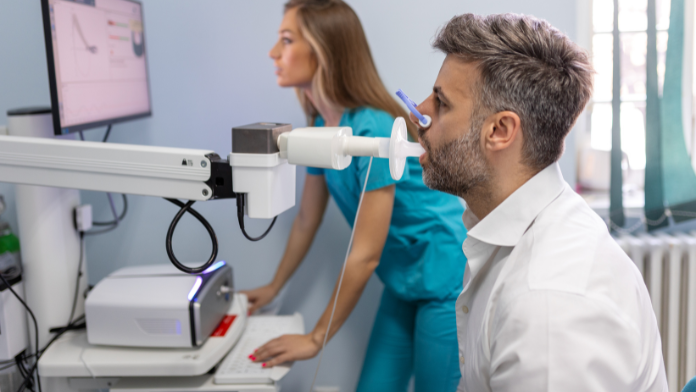The spirometry it is the exam that allows you to evaluate lung function of an individual. In particular, it measures the volume of inhaled and exhaled air and the strength of the respiratory flow, with the aim of preventing, diagnosing or monitoring any airway pathologies, which generally cause respiratory problems.
When is spirometry done?
Spirometry can be prescribed by your family doctor if the person complains of continuous respiratory problems like, for example, one chronic cough o if bronchopulmonary disease is suspected. Anyone who is exposed to large quantities of dust or volatile chemical substances, perhaps for work reasons, can also be tested. smokers or to patients with other pathologies to evaluate their general health status. Spirometry is also performed during competitive medical-sports visit.
This test can identify some diseases:
If these conditions have already been diagnosed previously, spirometry can be carried out to verify their evolution and the patient’s response to ongoing therapies.
How is it done?
Spirometry is performed while sitting, with one soft nose clip to prevent air from coming out of your nose. The person is asked to put a disposable mouthpiece, connected to the spirometer, i.e. the device that measures respiratory volumes and flows. You need to squeeze the mouthpiece tightly with your lips and teeth to prevent air leaks. Then we have to breathe in very deeplyuntil the lungs are fully filled, ed exhale for at least 6 secondsso as to completely empty the lungs.
The test is repeated several times until at least 3 readable traces are obtained. As the Istituto Superiore di Sanità points out, if the doctor deems it appropriate, spirometry can be repeated 15 minutes after taking an inhaled bronchodilator drug, to verify a possible improvement in the present respiratory pathology.
Is there any preparation needed before spirometry?
Preparation standards may vary from one center to another. In general, however, you need to:
avoid smoking within the previous 24 hours; avoid consuming large meals at least 2 hours before the exam; do not drink alcohol before the test; avoid intense physical exertion on the day of the exam; wear loose, comfortable clothing; suspend bronchodilator therapy on the same day as the test.
Is spirometry painful?
Spirometry is a safe, non-invasive and absolutely not painful. The test lasts 30 to 90 minutes, after which the individual can return home independently and carry out regular activities.
Are there contraindications and side effects?
As the ISS reminds us, people with hypertension not controlled pharmacologically, those who have recently suffered a heart attack or unstable angina and those who have undergone surgery on the head, chest, stomach or eyes should not undergo spirometry. At least until they get the all-clear from their doctor.
Regarding side effects, however, after carrying out the test some people may experience mild discomfort, such as dizziness, weakness, tiredness, feeling of heaviness in the head, chest, eyes.
